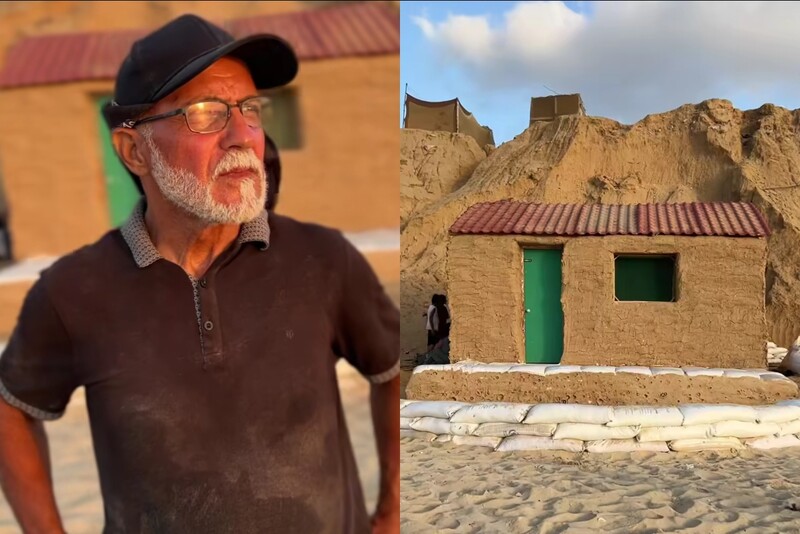The Electronic Intifada 10 October 2024

Motaz Barzaq and the beachhut he has built.
Gaza’s beaches have always been a haven for Gaza’s people.
In the long years of siege that came before last October, they were our vantage point from which we could see a world we weren’t allowed to visit, the promise of freedom for a territory imprisoned.
Since Israel’s genocide started, but especially since Israel’s invasion of Rafah back in May, the beaches have become even more important for tens of thousands of displaced people in Gaza.
People have pitched their tents in the sand in a desperate search for some safety.
Motaz Barzaq, who is displaced from the north, decided to go one step further.
Why not, he thought, build something a little more stable.
So he went to one of the bakeries that have popped up along the beach with the influx of the displaced and bought empty flour bags. These he filled with sand to build the walls of a cottage he then completed with mud.
The roof of his cottage is made of roof tiles he found. There is no end of rubble in Gaza from which to locate materials.
He even fitted the hut out with a kitchen, bathroom and bedroom.
“We have alternatives,” he told The Electronic Intifada with some pride. “If we don’t find the building materials, we return to tradition and do what our parents and ancestors did.”
The most beautiful place in Gaza
He used at least 2,000 sandbags to build the cottage, and it took him one month. He is now working on a sandbag wall to protect the hut from the tide.
Motaz believes his cottage is better than tents that, he said, don’t protect from the heat of the sun or the cold of winter. It was the intense summer heat that pushed Motaz to move to the beach, as staying in the displacement tent in Gaza during the day had become unbearable, he told The Electronic Intifada.
New businesses selling falafel, biscuits, juices, and iced water have sprung up along the beachfront and some young people have even found work there, providing a little income to support their families, and some focal point for those who now live on the beach.
Yahia Barzaq shared a video he took of Motaz building his cottage on social media.
“Not to romanticize reality, but to strengthen steadfastness, Motaz Barzaq, a displaced man from Gaza, tried to avoid the desperate life of tents, and sought a refuge by the sea, where the waves are louder than the chaos of war’s bombs,” Yahia comments in the video.
Motaz told Yahia that the idea of building the cottage came to him while living in a home in Deir al-Balah and explained that the hut’s mud and sandbag walls protect each other, ensuring that the mud doesn’t disintegrate with the rain.
“I was never going to make it from brick. I could have made it from canvas, which is much cheaper, but I wanted it to be more durable. And the flour bags didn’t cost me much,” Motaz said.
It was the lack of proper tools that was the biggest obstacle.
“The main difficulties I faced was the lack of screwdrivers. I had no saw, and there is barely any cement. Since we have no electricity, I could also only work during the day,” he said.
It was all worth it, and there is no question that his new address gives Motaz joy, even in Gaza’s bleakness. He had always wanted to live by the beach anyway.
“The sea is the most beautiful place in Gaza.”
Eman Alhaj Ali is a writer, translator and poet based in Gaza.





